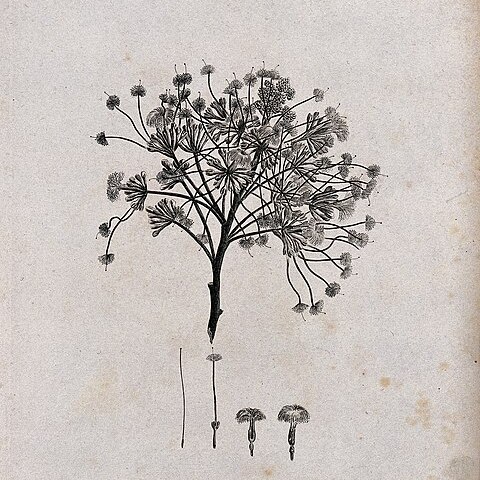Leaves: pinnae 5-7(8) pairs (rarely only 3 on occasional reduced leaves), each pinna ± narrowing upwards; leaflets of 2 distal pairs of pinnae 9-16(17) pairs, mostly c. 10-20(25) x 4-8(13) mm., obliquely rhombic-quadrate to rhombic-subfalcate, auricled (or sometimes not, but not in our area) on the proximal side, obtuse to acute at the apex, subglabrous or somewhat pubescent on the midrib and margins, rarely, especially when young, some occasional hairs on the primary lateral nerves; raised venation beneath lax.
A large spreading tree. It grows 30 m high. It is flat-topped. There are 2 varieties and it can form hybrids. It usually has smooth bark. The branches have fine hairs. The leaves are twice divided with 5-7 pairs of leaflet stalks and 9-16 pairs of leaflets. The leaflets are only hairy underneath along the midrib. The flowers are in half round heads. They are white. The fruit is a pod which is pale brown or reddish.
Medium or large tree up to 30 m. high; crown flattened; bark smooth, very rarely rough, grey; young branchlets finely and shortly brownish-pubescent, soon glabrescent and usually deep-or blackish-purple, ultimately grey-barked.
Pod dehiscent, (8)10-23·6 x 2-3·4(4) cm., oblong, flat or slightly transversely plicate, glabrescent, glossy, eglandular, less prominently and closely venose than in A. adianthifolia, pale-brown to reddish-brown or purplish.
Peduncles puberulous or finely pubescent; bracteoles mostly caducous, linear, inconspicuous, (1)2-6 mm. long, normally shorter than the flower-buds except when extremely young.
Calyx 2·5-5 (very rarely indeed 1·5-2·5) mm. long, minutely, shortly and rather appressedly brownish-pubescent to subglabrous outside.
Flowers subsessile; pedicels puberulous or sometimes glabrous, 0·25-0·75(1) mm. long.
Staminal tube exserted c. 1·5-2·8 cm. beyond the corolla, white below, crimson above.
Stipules and bracts at base of peduncles lanceolate, up to c. 6-7 x 2-2·5 mm.
Corolla 6·5-12 mm. long, minutely pubescent outside, white.
Seeds 8-12 x 8-10 mm., flattened.


